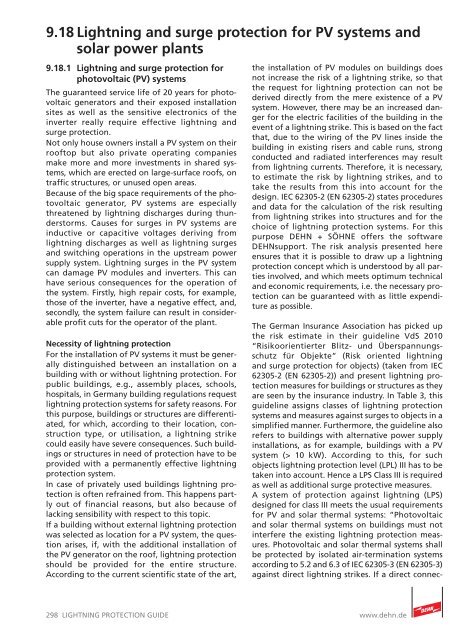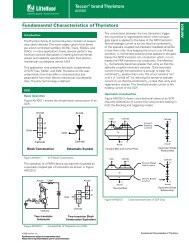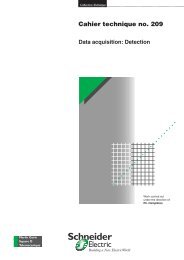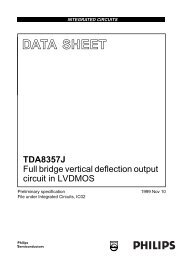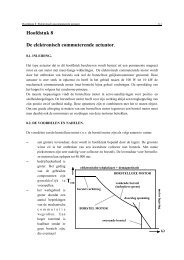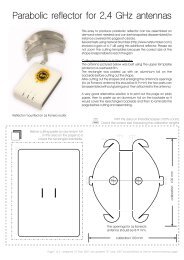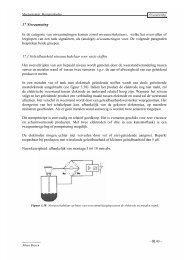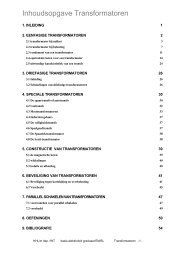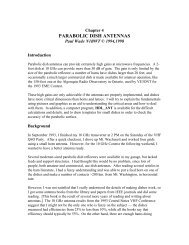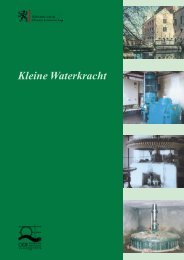9.18 Lightning and surge protection for PV systems and solar ... - Dehn
9.18 Lightning and surge protection for PV systems and solar ... - Dehn
9.18 Lightning and surge protection for PV systems and solar ... - Dehn
You also want an ePaper? Increase the reach of your titles
YUMPU automatically turns print PDFs into web optimized ePapers that Google loves.
<strong>9.18</strong> <strong>Lightning</strong> <strong>and</strong> <strong>surge</strong> <strong>protection</strong> <strong>for</strong> <strong>PV</strong> <strong>systems</strong> <strong>and</strong><br />
<strong>solar</strong> power plants<br />
<strong>9.18</strong>.1 <strong>Lightning</strong> <strong>and</strong> <strong>surge</strong> <strong>protection</strong> <strong>for</strong><br />
photovoltaic (<strong>PV</strong>) <strong>systems</strong><br />
The guaranteed service life of 20 years <strong>for</strong> photovoltaic<br />
generators <strong>and</strong> their exposed installation<br />
sites as well as the sensitive electronics of the<br />
inverter really require effective lightning <strong>and</strong><br />
<strong>surge</strong> <strong>protection</strong>.<br />
Not only house owners install a <strong>PV</strong> system on their<br />
rooftop but also private operating companies<br />
make more <strong>and</strong> more investments in shared <strong>systems</strong>,<br />
which are erected on large-surface roofs, on<br />
traffic structures, or unused open areas.<br />
Because of the big space requirements of the photovoltaic<br />
generator, <strong>PV</strong> <strong>systems</strong> are especially<br />
threatened by lightning discharges during thunderstorms.<br />
Causes <strong>for</strong> <strong>surge</strong>s in <strong>PV</strong> <strong>systems</strong> are<br />
inductive or capacitive voltages deriving from<br />
lightning discharges as well as lightning <strong>surge</strong>s<br />
<strong>and</strong> switching operations in the upstream power<br />
supply system. <strong>Lightning</strong> <strong>surge</strong>s in the <strong>PV</strong> system<br />
can damage <strong>PV</strong> modules <strong>and</strong> inverters. This can<br />
have serious consequences <strong>for</strong> the operation of<br />
the system. Firstly, high repair costs, <strong>for</strong> example,<br />
those of the inverter, have a negative effect, <strong>and</strong>,<br />
secondly, the system failure can result in considerable<br />
profit cuts <strong>for</strong> the operator of the plant.<br />
Necessity of lightning <strong>protection</strong><br />
For the installation of <strong>PV</strong> <strong>systems</strong> it must be generally<br />
distinguished between an installation on a<br />
building with or without lightning <strong>protection</strong>. For<br />
public buildings, e.g., assembly places, schools,<br />
hospitals, in Germany building regulations request<br />
lightning <strong>protection</strong> <strong>systems</strong> <strong>for</strong> safety reasons. For<br />
this purpose, buildings or structures are differentiated,<br />
<strong>for</strong> which, according to their location, construction<br />
type, or utilisation, a lightning strike<br />
could easily have severe consequences. Such buildings<br />
or structures in need of <strong>protection</strong> have to be<br />
provided with a permanently effective lightning<br />
<strong>protection</strong> system.<br />
In case of privately used buildings lightning <strong>protection</strong><br />
is often refrained from. This happens partly<br />
out of financial reasons, but also because of<br />
lacking sensibility with respect to this topic.<br />
If a building without external lightning <strong>protection</strong><br />
was selected as location <strong>for</strong> a <strong>PV</strong> system, the question<br />
arises, if, with the additional installation of<br />
the <strong>PV</strong> generator on the roof, lightning <strong>protection</strong><br />
should be provided <strong>for</strong> the entire structure.<br />
According to the current scientific state of the art,<br />
298 LIGHTNING PROTECTION GUIDE<br />
the installation of <strong>PV</strong> modules on buildings does<br />
not increase the risk of a lightning strike, so that<br />
the request <strong>for</strong> lightning <strong>protection</strong> can not be<br />
derived directly from the mere existence of a <strong>PV</strong><br />
system. However, there may be an increased danger<br />
<strong>for</strong> the electric facilities of the building in the<br />
event of a lightning strike. This is based on the fact<br />
that, due to the wiring of the <strong>PV</strong> lines inside the<br />
building in existing risers <strong>and</strong> cable runs, strong<br />
conducted <strong>and</strong> radiated interferences may result<br />
from lightning currents. There<strong>for</strong>e, it is necessary,<br />
to estimate the risk by lightning strikes, <strong>and</strong> to<br />
take the results from this into account <strong>for</strong> the<br />
design. IEC 62305-2 (EN 62305-2) states procedures<br />
<strong>and</strong> data <strong>for</strong> the calculation of the risk resulting<br />
from lightning strikes into structures <strong>and</strong> <strong>for</strong> the<br />
choice of lightning <strong>protection</strong> <strong>systems</strong>. For this<br />
purpose DEHN + SÖHNE offers the software<br />
DEHNsupport. The risk analysis presented here<br />
ensures that it is possible to draw up a lightning<br />
<strong>protection</strong> concept which is understood by all parties<br />
involved, <strong>and</strong> which meets optimum technical<br />
<strong>and</strong> economic requirements, i.e. the necessary <strong>protection</strong><br />
can be guaranteed with as little expenditure<br />
as possible.<br />
The German Insurance Association has picked up<br />
the risk estimate in their guideline VdS 2010<br />
“Risikoorientierter Blitz- und Überspannungsschutz<br />
für Objekte” (Risk oriented lightning<br />
<strong>and</strong> <strong>surge</strong> <strong>protection</strong> <strong>for</strong> objects) (taken from IEC<br />
62305-2 (EN 62305-2)) <strong>and</strong> present lightning <strong>protection</strong><br />
measures <strong>for</strong> buildings or structures as they<br />
are seen by the insurance industry. In Table 3, this<br />
guideline assigns classes of lightning <strong>protection</strong><br />
<strong>systems</strong> <strong>and</strong> measures against <strong>surge</strong>s to objects in a<br />
simplified manner. Furthermore, the guideline also<br />
refers to buildings with alternative power supply<br />
installations, as <strong>for</strong> example, buildings with a <strong>PV</strong><br />
system (> 10 kW). According to this, <strong>for</strong> such<br />
objects lightning <strong>protection</strong> level (LPL) III has to be<br />
taken into account. Hence a LPS Class III is required<br />
as well as additional <strong>surge</strong> protective measures.<br />
A system of <strong>protection</strong> against lightning (LPS)<br />
designed <strong>for</strong> class III meets the usual requirements<br />
<strong>for</strong> <strong>PV</strong> <strong>and</strong> <strong>solar</strong> thermal <strong>systems</strong>: “Photovoltaic<br />
<strong>and</strong> <strong>solar</strong> thermal <strong>systems</strong> on buildings must not<br />
interfere the existing lightning <strong>protection</strong> measures.<br />
Photovoltaic <strong>and</strong> <strong>solar</strong> thermal <strong>systems</strong> shall<br />
be protected by isolated air-termination <strong>systems</strong><br />
according to 5.2 <strong>and</strong> 6.3 of IEC 62305-3 (EN 62305-3)<br />
against direct lightning strikes. If a direct connec-<br />
www.dehn.de
tion can not be avoided, the effects of partial<br />
lightning currents entering the building have to be<br />
taken into consideration.”<br />
Protection of photovoltaic inverters against<br />
<strong>surge</strong>s also in case of direct lightning strikes<br />
If a <strong>PV</strong> system shall be installed on a building with<br />
external lightning <strong>protection</strong> system, one of the<br />
basic requirements is that the <strong>PV</strong> modules are<br />
within the protective area of an isolated air-termination<br />
system. Additionally, the separation distance<br />
between the <strong>PV</strong> supporting frame <strong>and</strong> the<br />
external lightning <strong>protection</strong> system has to be<br />
kept in order to prevent uncontrolled sparkover.<br />
Otherwise considerable partial lightning currents<br />
can be carried into the building or structure.<br />
Often the operator wants the whole roof to be<br />
covered with <strong>PV</strong> modules in order to gain a possibly<br />
high economic profit. In these cases the separation<br />
distance often can not be realised <strong>and</strong> the <strong>PV</strong><br />
supporting frame has to be integrated into the<br />
external lightning <strong>protection</strong>. Here, the effects of<br />
the currents coupled into the building or structure<br />
have to be taken into consideration <strong>and</strong> a lightning<br />
equipotential bonding has to be provided.<br />
Meaning that lightning equipotential bonding<br />
now also is necessary <strong>for</strong> the d.c. conductors carrying<br />
lightning current. According to IEC 62305-3 the<br />
d.c. conductors have to be protected by <strong>surge</strong> protective<br />
devices (SPDs) Type 1. Surge protective<br />
devices Type 1 on spark gap basis, <strong>for</strong> use on the<br />
d.c. voltage side, were not available up to now.<br />
The problem was that the spark gap once being<br />
tripped, could not be<br />
quenched again <strong>and</strong> hence<br />
the arc persisted.<br />
With the combined lightning<br />
current <strong>and</strong> <strong>surge</strong> arrester<br />
DEHNlimit <strong>PV</strong> 1000 (Figure<br />
<strong>9.18</strong>.1.1) DEHN + SÖHNE succeeded<br />
in developing a direct<br />
current extinguishing spark<br />
gap arrester. Thus DEHNlimit<br />
<strong>PV</strong> 1000 is the ideal arrester<br />
<strong>for</strong> use in photovoltaic power<br />
plants. The encapsulated<br />
creeping spark gap technology<br />
provides a safe <strong>protection</strong><br />
of the <strong>PV</strong> generator <strong>and</strong> the<br />
inverter also in case of direct<br />
Fig. <strong>9.18</strong>.1.1 Combined arrester Type 1, DEHNlimit <strong>PV</strong>,<br />
to protect photovoltaic inverters from <strong>surge</strong>s<br />
also in case of direct lightning strikes<br />
lightning currents. This combined arrester is applicable<br />
<strong>for</strong> <strong>PV</strong> <strong>systems</strong> up to 1000 V U OC STC . DEHNlimit<br />
<strong>PV</strong> 1000 has a high lightning current discharge<br />
capability of 50 kA 10/350 μs.<br />
Single pole photovoltaic arrester Type 2 with integrated<br />
short-circuiting device<br />
The inner structure of DEHNguard <strong>PV</strong> 500 SCP a<br />
<strong>surge</strong> arrester Type 2 (Figure <strong>9.18</strong>.1.2) sets new patterns<br />
<strong>for</strong> safety. In this arrester the proved double<br />
effect of the monitoring <strong>and</strong> disconnecting device<br />
Thermo Dynamic Control has been combined with<br />
an additional short-circuiting device. This completely<br />
new kind of arrester monitoring ensures<br />
operation safety without risk of fire hazard, even<br />
if the devices are overloaded <strong>for</strong> example at insulation<br />
faults in the <strong>PV</strong> generator circuit. The following<br />
example explains the effectiveness of the<br />
short-circuiting device in DEHNguard <strong>PV</strong> 500 SCP:<br />
1. Figure <strong>9.18</strong>.1.3: An insulation fault arises during<br />
the operation of the <strong>PV</strong> system.<br />
2. Figure <strong>9.18</strong>.1.4: With the consequence of the<br />
<strong>surge</strong> arrester being overloaded by the exceeding<br />
maximum continuous voltage Uc .<br />
3. Figure <strong>9.18</strong>.1.5: The combined disconnection<br />
<strong>and</strong> short-circuiting device of DEHNguard <strong>PV</strong><br />
500 SCP will be activated. It is able to carry a<br />
short-circuit current up to 50 A automatically<br />
until the <strong>PV</strong> system is repaired. This ensures a<br />
safe operation without risk of fire hazard <strong>for</strong><br />
the system even at an insulation fault in the <strong>PV</strong><br />
generator circuit.<br />
Fig. <strong>9.18</strong>.1.2 Single pole photovoltaic<br />
arrester Type 2,<br />
DEHNguard <strong>PV</strong> 500 SCP,<br />
with integrated shortcircuiting<br />
device<br />
www.dehn.de LIGHTNING PROTECTION GUIDE 299
+<br />
–<br />
SCP SCP<br />
Fig. <strong>9.18</strong>.1.3 Isolation fault at the <strong>PV</strong> generator<br />
+<br />
–<br />
SCP SCP<br />
Fig. <strong>9.18</strong>.1.4 Overloading of SPD due to an isolation fault<br />
+<br />
–<br />
SCP SCP<br />
300 LIGHTNING PROTECTION GUIDE<br />
–<br />
+<br />
=<br />
=<br />
=<br />
~<br />
~<br />
~<br />
Fig. <strong>9.18</strong>.1.5 Activation of the DEHNguard <strong>PV</strong> 500 SCP disconnecting<br />
<strong>and</strong> short-circuiting device ensures safe operating<br />
state also in case of an isolation fault in the <strong>PV</strong> generator<br />
circuit<br />
–<br />
+<br />
Examples of application<br />
Buildings without external lightning <strong>protection</strong><br />
system<br />
Figure <strong>9.18</strong>.1.6 shows the <strong>surge</strong> <strong>protection</strong> concept<br />
<strong>for</strong> a <strong>PV</strong> system on a building without external<br />
lightning <strong>protection</strong> system. Possible installation<br />
sites of the <strong>surge</strong> protective devices can be:<br />
⇒ d.c. input of the inverter<br />
⇒ a.c. output of the inverter<br />
⇒ low-voltage (l.v.) supply<br />
DEHNguard, an SPD Type 2 is installed in the l.v.<br />
incoming feeder. This DEHNguard M Type of <strong>surge</strong><br />
arrester, a complete prewired unit is available <strong>for</strong><br />
each low-voltage system (TN-C, TN-S, TT) (Table<br />
<strong>9.18</strong>.1.1). If the distance between the <strong>PV</strong> inverter<br />
<strong>and</strong> the installation site of the DEHNguard is not<br />
greater than 5 m (l.v. supply), the a.c. output of the<br />
inverter is sufficiently protected. At greater conductor<br />
lengths additional <strong>surge</strong> protective devices<br />
SPDs Type 2 are necessary upstream the a.c. input<br />
of the inverter (Table <strong>9.18</strong>.1.1).<br />
At the d.c. input of the inverter each of the incoming<br />
string conductors has to be protected to earth<br />
by a DEHNguard <strong>surge</strong> protective device Type <strong>PV</strong><br />
500 SCP installed between plus <strong>and</strong> minus. This<br />
installation provides safe <strong>surge</strong> <strong>protection</strong> <strong>for</strong> <strong>PV</strong><br />
<strong>systems</strong> with a generator voltage up to 1000 V d.c..<br />
The operating voltage of the chosen <strong>surge</strong> protective<br />
devices shall be approx. 10 % higher than the<br />
expected open-circuit voltage of the <strong>solar</strong> generator<br />
during maximum <strong>solar</strong>isation on a cold winter<br />
day.<br />
Buildings with external lightning <strong>protection</strong> system<br />
<strong>and</strong> separation distance kept<br />
The correct operating condition of the lightning<br />
<strong>protection</strong> system has to be proven by existing test<br />
reports or by maintenance tests. If faults are found<br />
during the examination of the external lightning<br />
<strong>protection</strong> system (i.e. intense corrosion, loose <strong>and</strong><br />
free clamping elements), the constructor of the <strong>PV</strong><br />
system has the duty to in<strong>for</strong>m the owner of the<br />
building about these faults in writing.<br />
The <strong>PV</strong> system on the roof surface should be<br />
designed under consideration of the existing<br />
external lightning <strong>protection</strong> system. For this purpose,<br />
the <strong>PV</strong> system has to be installed within the<br />
<strong>protection</strong> zone of the external lightning protec-<br />
www.dehn.de
DNO<br />
a.c.<br />
output<br />
2<br />
~<br />
3<br />
=<br />
meter/main<br />
distribution<br />
SEB<br />
d.c.<br />
input<br />
kWh kWh<br />
1<br />
earthing<br />
conductor<br />
Fig. <strong>9.18</strong>.1.6 Surge <strong>protection</strong> concept <strong>for</strong> a <strong>PV</strong> system on a building without external lightning<br />
<strong>protection</strong><br />
Figure<br />
<strong>9.18</strong>.1.6<br />
L.v. supply<br />
1<br />
2<br />
Protection<br />
<strong>for</strong>...<br />
tion system to ensure its <strong>protection</strong><br />
against a direct lightning<br />
strike. By using suitable air-termination<br />
<strong>systems</strong>, like air-termination<br />
rods, <strong>for</strong> example, direct lightning<br />
strikes into the <strong>PV</strong> modules<br />
can be prevented. The necessary<br />
air-termination rods possibly to be<br />
installed additionally, must be<br />
arranged to prevent a direct strike<br />
into the <strong>PV</strong> module within their<br />
<strong>protection</strong> zone <strong>and</strong>, secondly, any<br />
casting of a shadow on the modules.<br />
It has to be considered that a separation<br />
distance s must be kept<br />
between the <strong>PV</strong> components <strong>and</strong><br />
metal parts like lightning <strong>protection</strong><br />
<strong>systems</strong>, rain gutters, skylights,<br />
<strong>solar</strong> cells or antenna <strong>systems</strong><br />
in compliance with IEC<br />
62305-3 (EN 62305-3). The separation<br />
distance has to be calculated<br />
according to IEC 62305-3 (EN<br />
62305-3)3. The <strong>PV</strong> system shown in<br />
Figure <strong>9.18</strong>.1.7 is located in the<br />
protective area of the external<br />
lightning <strong>protection</strong> system. Figure<br />
<strong>9.18</strong>.1.7 illustrates the concept of<br />
SPDs Part No.<br />
TN-C system DEHNguard M, DG M TNC 275<br />
DEHNguard M, DG M TNC 275 FM<br />
TN-S system DEHNguard M, DG M TNS 275<br />
DEHNguard M, DG M TNS 275 FM<br />
TT system DEHNguard M, DG M TT 275<br />
DEHNguard M, DG M TT 275 FM<br />
Ac output of the inverter/ac, inverter installed in the attic<br />
TN system DEHNguard M, DG M TN 275<br />
DEHNguard M, DG M TN 275 FM<br />
TT system DEHNguard M, DG M TT 2P 275<br />
DEHNguard M, DG M TT 2P 275 FM<br />
Dc input of the inverter<br />
2 x<br />
3 (each between plus<br />
<strong>and</strong> minus to earth)<br />
DEHNguard, DG <strong>PV</strong> 500 SCP<br />
DEHNguard, DG <strong>PV</strong> 500 SCP FM<br />
Table <strong>9.18</strong>.1.1 Selection of the <strong>surge</strong> protective devices <strong>for</strong> <strong>PV</strong> <strong>systems</strong> on buildings without external lightning <strong>protection</strong> system<br />
952 300<br />
952 305<br />
952 400<br />
952 405<br />
952 310<br />
952 315<br />
952 200<br />
952 205<br />
952 110<br />
952 115<br />
950 500<br />
950 505<br />
www.dehn.de LIGHTNING PROTECTION GUIDE 301
DNO<br />
DNO<br />
a.c.<br />
output<br />
a.c.<br />
output<br />
2<br />
~<br />
3<br />
=<br />
meter/main<br />
distribution<br />
SEB<br />
Fig. <strong>9.18</strong>.1.7 Surge <strong>protection</strong> concept <strong>for</strong> a <strong>PV</strong> system on a building with external lightning<br />
<strong>protection</strong> system <strong>and</strong> the separation distance is being kept<br />
2<br />
~<br />
3<br />
=<br />
meter/main<br />
distribution<br />
SEB<br />
302 LIGHTNING PROTECTION GUIDE<br />
kWh kWh<br />
At the d.c. input of the inverter each of the incoming<br />
string conductors has to be protected to earth<br />
by a DEHNguard <strong>surge</strong> protective device Type <strong>PV</strong><br />
500 SCP installed between plus <strong>and</strong> minus.<br />
Buildings with external lightning <strong>protection</strong> system<br />
<strong>and</strong> separation distance not kept<br />
Often the whole roof is covered with <strong>PV</strong> modules<br />
in order to gain a possibly high economic profit.<br />
For the mounting technicians, however, then it is<br />
often not possible to keep the required separation<br />
distance. At these points a direct conductive connection<br />
must be provided between the external<br />
lightning <strong>protection</strong> system <strong>and</strong> the metal <strong>PV</strong> components.<br />
In this case, however, the effects of the<br />
2<br />
TN system DEHNguard M, DG M TN 275<br />
DEHNguard M, DG M TN 275 FM<br />
TT system DEHNguard M, DG M TT 2P 275<br />
DEHNguard M, DG M TT 2P 275 FM<br />
currents carried into the structure or building via<br />
the d.c. conductors have to be taken into account<br />
<strong>and</strong> hence lightning equipotential bonding has to<br />
be ensured. Meaning that now also the lightning<br />
current carrying d.c. conductors have to be included<br />
into the lightning equipotential bonding (Figure<br />
<strong>9.18</strong>.1.8). According to IEC 62305-3 (EN 62305-<br />
3), <strong>surge</strong> protective devices Type 1 have to be<br />
installed at the d.c. conductors. Here DEHNlimit <strong>PV</strong><br />
1000, the combined lightning current <strong>and</strong> <strong>surge</strong><br />
arrester is used, which in this case will be connected<br />
in parallel with the string conductor. The combined<br />
arrester DEHNlimit <strong>PV</strong> 1000 has been especially<br />
developed <strong>for</strong> application in photovoltaic<br />
power plants. The encapsulated creeping spark<br />
Figure<br />
<strong>9.18</strong>.1.7<br />
L.v. supply<br />
Protection <strong>for</strong>... SPDs Part No.<br />
TN-C system DEHNventil ZP, DV ZP TNC 255 900 390<br />
1 TN-S system <strong>and</strong><br />
TT system<br />
DEHNventil ZP, DV ZP TT 255 900 391<br />
A.c. output of the inverter/a.c., inverter installed in the attic<br />
D.c. input of the inverter<br />
2 x<br />
3 (each between plus<br />
<strong>and</strong> minus to earth)<br />
Figure<br />
<strong>9.18</strong>.1.8<br />
L.v. supply<br />
2<br />
DEHNguard, DG <strong>PV</strong> 500 SCP<br />
DEHNguard, DG <strong>PV</strong> 500 SCP FM<br />
Table <strong>9.18</strong>.1.2 Selection of the <strong>surge</strong> protective devices <strong>for</strong> <strong>PV</strong> <strong>systems</strong> on buildings with external lightning <strong>protection</strong> system <strong>and</strong> the<br />
separation distance is being kept<br />
952 200<br />
952 205<br />
952 110<br />
952 115<br />
950 500<br />
950 505<br />
Protection <strong>for</strong>... SPDs Part No.<br />
TN-C system DEHNventil ZP, DV ZP TNC 255 900 390<br />
DEHNventil ZP, DV ZP TT 255 900 391<br />
1 TN-S system <strong>and</strong><br />
TT system<br />
A.c. output of the inverter/a.c., inverter installed in the attic<br />
TN-C system DEHNventil M, DV M TN 255<br />
DEHNventil M, DV M TN 255 FM<br />
TT-S system <strong>and</strong><br />
TT system<br />
DEHNventil M, DV M TT 255<br />
DEHNventil M, DV M TT 255 FM<br />
951 200<br />
951 205<br />
951 110<br />
951 115<br />
D.c. input of the inverter<br />
3 Each string conductor DEHNlimit, DLM <strong>PV</strong> 1000 900 330<br />
Table <strong>9.18</strong>.1.3 Selection of the <strong>surge</strong> protective devices <strong>for</strong> <strong>PV</strong> <strong>systems</strong> on buildings with external lightning <strong>protection</strong> <strong>and</strong> the separation<br />
distance is not being kept<br />
www.dehn.de LIGHTNING PROTECTION GUIDE 303
gap technology provides safe <strong>protection</strong> of the <strong>PV</strong><br />
generator, even at direct lightning currents.<br />
<strong>Lightning</strong> equipotential bonding has to be per<strong>for</strong>med<br />
also <strong>for</strong> the l.v. input. The DEHNventil ZP, a<br />
<strong>surge</strong> protective device with spark gap technology<br />
is used there (Table <strong>9.18</strong>.1.3). If the distance<br />
between the <strong>PV</strong> inverter <strong>and</strong> the l.v. input is not<br />
greater than 5 m, the a.c. output of the inverter is<br />
also protected. Surge <strong>protection</strong> measures always<br />
are effective only locally, which applies also <strong>for</strong> the<br />
<strong>protection</strong> of the <strong>PV</strong> inverter. The <strong>PV</strong> inverter<br />
being installed in the attic, additional <strong>surge</strong> protective<br />
devices are necessary to protect the a.c.<br />
output of the inverter, to be per<strong>for</strong>med in this case<br />
also by the DEHNventil <strong>surge</strong> protective devices<br />
Type 1. This protective device is used because the<br />
partial lightning currents flowing via the protective<br />
conductor <strong>and</strong> the a.c. supply conductor have<br />
to be controlled by the <strong>surge</strong> protective device.<br />
Note<br />
The <strong>surge</strong> <strong>protection</strong> of so-called thin-film module<br />
applications possibly requires separate consideration.<br />
Air-termination rod<br />
Generator junction box<br />
<strong>PV</strong> array<br />
operation<br />
building<br />
304 LIGHTNING PROTECTION GUIDE<br />
Earth-termination system<br />
Mesh size 20 x 20 m<br />
d.c. line<br />
Fig. <strong>9.18</strong>.2.1 Layout of a large <strong>PV</strong> installation in an open area<br />
<strong>9.18</strong>.2 <strong>Lightning</strong> <strong>and</strong> <strong>surge</strong> <strong>protection</strong> <strong>for</strong><br />
<strong>solar</strong> power plants<br />
For such a complex type of installation as a <strong>solar</strong><br />
power plant, it is necessary to make an assessment<br />
of the damage risk due to lightning strikes according<br />
to IEC 62305-2 (EN 62305-2), the result to be<br />
taken into account on designing. In case of a <strong>solar</strong><br />
power plant the aim is to protect both the operation<br />
building <strong>and</strong> the <strong>PV</strong> array against damage by<br />
fire (direct lightning strike), <strong>and</strong> the electrical <strong>and</strong><br />
electronic <strong>systems</strong> (inverters, remote diagnostics<br />
system, generator main line) against the effects of<br />
lightning electromagnetic impulses (LEMP).<br />
Air-termination system <strong>and</strong> down-conductor system<br />
For protecting the <strong>PV</strong> array against direct lightning<br />
strikes, it is necessary to arrange the <strong>solar</strong> modules<br />
in the <strong>protection</strong> zone of an isolated air-termination<br />
system. Its design is based on lightning <strong>protection</strong><br />
system Class III <strong>for</strong> <strong>PV</strong> <strong>systems</strong> greater 10 kW in<br />
compliance with VdS guideline 2010. According to<br />
the class of lightning <strong>protection</strong> system, the height<br />
<strong>and</strong> the quality of the air-termination rods required<br />
is determined by means of the rolling<br />
sphere. Furthermore, it has to be ensured that the<br />
separation distance s is kept between the <strong>PV</strong> supporting<br />
frames <strong>and</strong> the air-termination rods in<br />
compliance with IEC 62305-3 (EN 62305-3). Also,<br />
the operation building is equipped with an external<br />
lightning <strong>protection</strong> system Class III. The down<br />
conductors are connected with the earth-termination<br />
system by using terminal lugs. Due to the corrosion<br />
risk at the point where the terminal lugs<br />
come out of the soil or concrete, they have to be<br />
made out of corrosion-resistant material (stainless<br />
steel V4A, Material No. 1.4571) or, in case of using<br />
galvanised steel they have to be protected by corresponding<br />
measures (applying sealing tape or<br />
heat-shrinkable tubes, <strong>for</strong> example).<br />
Earthing system<br />
The earthing system of the <strong>PV</strong> system is designed<br />
as a ring earth electrode (surface earth electrode)<br />
with a mesh size of 20 m x 20 m (Figure <strong>9.18</strong>.2.1).<br />
The metal supporting frames which the <strong>PV</strong> modules<br />
are fixed onto, are connected to the earthtermination<br />
system approx. every 10 m. The earthing<br />
system of the operation building is designed as<br />
a foundation earth electrode according to DIN<br />
18014 (German st<strong>and</strong>ard). The earth-termination<br />
www.dehn.de
uilding with inverter<br />
system of the <strong>PV</strong> system <strong>and</strong> the one of the operation<br />
building have to be connected with each other<br />
via at least one conductor (30 mm x 3.5 mm steel<br />
strip V4A, Material No. 1.4571 or galvanised steel).<br />
The interconnection of the individual earthing <strong>systems</strong><br />
reduces considerably the total earthing resistance.<br />
The intermeshing of the earthing <strong>systems</strong><br />
creates an equipotential surface which reduces<br />
∼<br />
=<br />
1 2<br />
foundation earth electrode<br />
generator<br />
junction<br />
box<br />
Fig. <strong>9.18</strong>.2.2 Basic circuit diagram – Surge <strong>protection</strong> <strong>for</strong> a <strong>solar</strong> power plant<br />
No. in Fig.<br />
<strong>9.18</strong>.2.2<br />
1<br />
2<br />
3<br />
3<br />
steel telescopic<br />
lightning <strong>protection</strong> mast<br />
<strong>PV</strong> modules<br />
Protection <strong>for</strong>... SPDs Part No.<br />
TN-C system<br />
TN-S system<br />
TT system<br />
DEHNventil, DV M TNC 255<br />
DEHNventil, DV M TNS 255<br />
DEHNventil, DV M TT 255<br />
considerably the voltage load of lightning effects<br />
on the electric connecting cables between <strong>PV</strong> array<br />
<strong>and</strong> operation building. The surface earth electrodes<br />
are laid at least 0.5 m deep in the soil. The<br />
meshes are interconnected with four-wire connectors.<br />
The joints in the soil have to be wrapped with<br />
an anticorrosive b<strong>and</strong>. This also applies to V4A<br />
steel strips laid in the soil.<br />
www.dehn.de LIGHTNING PROTECTION GUIDE 305<br />
3<br />
951 300<br />
951 400<br />
951 310<br />
D.c. input of the inverter DEHNlimit, DLM <strong>PV</strong> 1000 900 330<br />
Generator junction box<br />
Table <strong>9.18</strong>.2.1 Selection of <strong>surge</strong> protective devices <strong>for</strong> <strong>solar</strong> power plants<br />
DEHNguard DG <strong>PV</strong> 500 SCP<br />
DEHNguard DG <strong>PV</strong> 500 SCP FM<br />
950 500<br />
950 505
<strong>Lightning</strong> equipotential bonding<br />
In principle, all conductive <strong>systems</strong>, entering the<br />
operation building from outside, have to be generally<br />
included into the lightning equipotential<br />
bonding. The requirements of lightning equipotential<br />
bonding are fulfilled by the direct connection<br />
of all metal <strong>systems</strong> <strong>and</strong> by the indirect connection<br />
of all live <strong>systems</strong> via lightning current<br />
306 LIGHTNING PROTECTION GUIDE<br />
1<br />
∼<br />
NTBA modem<br />
=<br />
2<br />
acquisition<br />
unit <strong>for</strong><br />
measured values<br />
Fig. <strong>9.18</strong>.2.3 Protection concept <strong>for</strong> data acquisition <strong>and</strong> evaluation<br />
No. in Fig.<br />
<strong>9.18</strong>.2.3<br />
1<br />
2<br />
3<br />
4<br />
3<br />
4<br />
4<br />
Protection <strong>for</strong>... SPDs Part No.<br />
Network <strong>and</strong> data input of an NTBA NT PRO 909 958<br />
Measuring <strong>and</strong> control <strong>systems</strong> <strong>and</strong> devices with<br />
four-wire data transmission e.g. RS 485 bus <strong>systems</strong><br />
BLITZDUCTOR VT, BVT RS 485 5 918 401<br />
Wind direction indicators, e.g. analogue<br />
transmission of measured values 4 to 20 mA<br />
Sensor <strong>for</strong> environment <strong>and</strong> module<br />
temperature<br />
Table <strong>9.18</strong>.2.2 Surge protective devices <strong>for</strong> data acquisition <strong>and</strong> evaluation<br />
BLITZDUCTOR XT, BXT ML4 BE 24<br />
+ Base part BXT BAS<br />
BLITZDUCTOR XT, BXT ML4 BE 5<br />
+ Base part BXT BAS<br />
arresters. <strong>Lightning</strong> equipotential bonding should<br />
be per<strong>for</strong>med preferably near the entrance of the<br />
structure in order to prevent partial lightning currents<br />
from penetrating the building. In this case<br />
(Figure <strong>9.18</strong>.2.2), the low voltage power supply in<br />
the operation building is protected by a multi pole<br />
DEHNventil combined lightning current <strong>and</strong> <strong>surge</strong><br />
arrester (see Table <strong>9.18</strong>.2.1).<br />
www.dehn.de<br />
920 324<br />
920 300<br />
920 320<br />
920 300
Furthermore, the d.c. lines entering the <strong>PV</strong> inverter<br />
in the operation building have to be protected<br />
by a suitable spark-gap-based lightning current<br />
arrester, such as DEHNlimit <strong>PV</strong> 1000, a combined<br />
lightning current <strong>and</strong> <strong>surge</strong> arrester.<br />
Surge protective measures in the <strong>PV</strong> array<br />
In order to reduce the load on the isolation inside<br />
the <strong>solar</strong> modules at a lightning strike into the isolated<br />
air-termination system, thermally controlled<br />
<strong>surge</strong> protective devices are installed in a generator<br />
junction box as close as possible to the <strong>PV</strong> generator.<br />
For generator voltages up to 1000 V d.c., a<br />
DEHNguard <strong>PV</strong> 500 SCP type of <strong>surge</strong> protective<br />
device is installed here between plus <strong>and</strong> minus to<br />
earth. In this case <strong>surge</strong> protective devices Type 2<br />
are sufficient because the <strong>PV</strong> modules are within<br />
the protective area of the external lightning <strong>protection</strong>.<br />
In practice, it is a proven method to use <strong>surge</strong> protective<br />
devices with floating contacts to indicate<br />
the operating state of the thermal disconnection<br />
device. Thus, the intervals between the regular onsite<br />
inspections of the <strong>protection</strong> devices are<br />
extended.<br />
The <strong>surge</strong> protective devices in the generator junction<br />
boxes assume the <strong>protection</strong> <strong>for</strong> the <strong>PV</strong> modules<br />
locally <strong>and</strong> ensure that no sparkovers caused<br />
by conducted or field-related interferences come<br />
up at the <strong>PV</strong> modules.<br />
Note<br />
The <strong>surge</strong> <strong>protection</strong> of so-called thin-film module<br />
applications possibly requires separate consideration.<br />
Surge protective measures <strong>for</strong> data processing<br />
<strong>systems</strong><br />
The operation building provides a remote diagnostics<br />
system, which is used <strong>for</strong> a simple <strong>and</strong> quick<br />
function check of the <strong>PV</strong> <strong>systems</strong>. This allows the<br />
operator to recognise <strong>and</strong> remedy malfunctions in<br />
good time. The remote supervisory control system<br />
provides the per<strong>for</strong>mance data of the <strong>PV</strong> generator<br />
constantly in order to optimise the output of<br />
the <strong>PV</strong> system.<br />
As shown in Figure <strong>9.18</strong>.2.3, measurements of<br />
wind velocity, module temperature <strong>and</strong> ambient<br />
temperature are per<strong>for</strong>med via external sensors at<br />
the <strong>PV</strong> system. These measurements can be read<br />
directly from the acquisition unit. The data acquisition<br />
unit provides interfaces like RS 232 or RS 485,<br />
which a PC <strong>and</strong>/or modems are connected to <strong>for</strong><br />
remote enquiry <strong>and</strong> maintenance. Thus, the service<br />
engineers can determine the cause of a malfunction<br />
by telediagnosis <strong>and</strong> then directly eliminate<br />
it. The modem in Figure <strong>9.18</strong>.2.3 is connected<br />
to the network termination unit (NTBA) of an ISDN<br />
basic access.<br />
The measuring sensors <strong>for</strong> wind velocity <strong>and</strong> module<br />
temperature are also installed in the zone protected<br />
against lightning strikes like the <strong>PV</strong> modules.<br />
Thus, no lightning currents come up in the<br />
measuring leads, but probably conducted transient<br />
<strong>surge</strong>s resulting from induction effects in the<br />
event of lightning strikes into the isolated air-termination<br />
system.<br />
In order to provide a reliable trouble-free <strong>and</strong> continuous<br />
transmission of the measured data to the<br />
measuring unit, it is necessary, to lead the sensor<br />
cables entering the building via <strong>surge</strong> protective<br />
devices (Table <strong>9.18</strong>.2.2). When choosing the protective<br />
devices, it has to be ensured that the measurements<br />
cannot be impaired. The <strong>for</strong>warding of<br />
the measured data via the telecommunication network<br />
per ISDN modem must be provided as well, in<br />
order to provide a continuous control <strong>and</strong> optimisation<br />
of the per<strong>for</strong>mance of the installation. For<br />
this purpose, the U k0 interface upstream of the<br />
NTBA which the ISDN modem is connected to, is<br />
protected by a <strong>surge</strong> protective adapter. This<br />
adapter ensures additional <strong>protection</strong> <strong>for</strong> the<br />
230 V power supply of the NTBA.<br />
www.dehn.de LIGHTNING PROTECTION GUIDE 307


